Dog Training a Leash-Refusing Dog
How to effectively train a dog that refuses to walk on a leash. Mastering this skill is crucial for maintaining good dog etiquette and ensuring the well-being and safety of your beloved pet.
According to the Joint World Food and Agriculture Programme of the World Health Organisation, walking is highly recommended to prevent various types of cancers and heart disease.
Just because your furry friend doesn’t need to step on the scale doesn’t mean they can’t benefit from daily walks. It’s a simple and enjoyable way to keep them physically active and mentally stimulated.
Throughout this article, we will discuss:
- Understanding why your dog may be hesitant to walk on a leash
- Getting ready for leash training: A detailed guide to help you train a dog that refuses to walk on a leash
- Addressing common problems
- Expert advice for mastering leash training
- Discover the advantages of leash training
When you’ve finished reading this guide, you’ll be equipped with the know-how and equipment needed to get your dog to walk peacefully on a loose leash – even if they initially put up quite a fight.
As in any dog training situation, the key is patience and consistency.
Understanding Your Dog’s Reluctance to Walk on a Leash
Before you start leash training, understanding the reasons behind your dog’s resistance to walking on a leash is crucial.

Suppose the dog is not at ease with being connected to the leash. In that case, it is unrealistic to anticipate immediate compliance with the rules and the display of proper leash behavior.
Dealing with fear or anxiety
Introducing a leash to a fearful dog may not be advisable, mainly if it is their first time encountering one.
When confronted with an unfamiliar situation, fearful dogs may exhibit signs such as quivering, trembling, or attempting to escape.
Insufficient Socialisation
Ensuring that dogs are exposed to a wide range of experiences during socialization and throughout their lives is crucial to prevent them from developing uncertainty and fear.
An environmental enrichment program typically involves providing various environments, people, and animals with which the dog can safely and engagingly interact.
The goal is to ensure the dog is well-adjusted and comfortable in various situations. You can find more ideas for an environmental enrichment program by searching online.
Past Unpleasant Experiences
If a dog has had a negative experience while on a leash, such as being dragged or jerked, they may develop a negative association with the leash.
If you want to help your dog regain confidence after a negative experience, take a deep breath and focus on creating a positive connection between the leash and walking.
Insufficient leash training
If dogs haven’t been properly introduced to a leash or haven’t received consistent training on walking on a leash, they may feel confused when put on one.
They may struggle to comprehend what is expected of them and, in numerous instances, may resist the concept altogether.
Many dogs initially view being on a leash as a form of confinement and will try to break free.
They eagerly seek any enticing scent while strolling along the sidewalk, if possible.
Medical Issues
It’s normal for dogs sometimes to resist walking on a leash.
It is common for dogs to engage in occasional fights, particularly when they are still adjusting to wearing a collar and walking on a leash.
You’re not alone if your dog consistently and persistently resists walking on a leash. Your owners face this challenge.
Some dogs we’re familiar with have been described as not enjoying or disliking being walked on a leash.
There are instances where this behavior could be linked to underlying medical conditions such as joint pain, injuries, or illnesses that cause discomfort or even pain during walks for the dog.
Sometimes, it’s possible to identify the exact issue with your dog’s behavior and address it directly. However, there are instances when you can’t identify any specific cause for the inappropriate behavior and need to rely on general troubleshooting techniques.
Preparing for Leash Training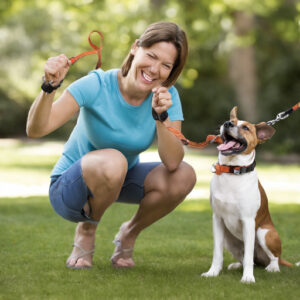
It is highly recommended that you ensure you have the right tools and set up a positive environment for leash training your dog.
Andalusian dogs may need some practice and patience when undertaking this new task. At first, they might tug on the dog’s leash enthusiastically as they eagerly explore their surroundings.
Using a gentle yet consistent approach, it is necessary to apply leash pressure to teach these dogs how to walk nicely on a leash.
Using outdated choke collars or any other devices that constrict a dog’s neck can cause unnecessary discomfort and harm.
These devices can be pretty uncomfortable and even dangerous for dogs. Tight collars, for example, can restrict airflow and cause heart irregularities. This is not what any pet owner wants, especially when engaging their furry friend in doggy aerobics!
Choosing the Right Collar and Leash
Choosing the right leash and collar is essential for practical leash training. There are a wide range of collars to choose from, including:
- Flat collars
- Martingale collars
- Head halters
- Harnesses
If your dog tends to lunge or pull during walks, you might want to consider using a head halter or an “easy walk” harness” instead “of the traditional collar and leash.
These types of collars serve two crucial purposes:
They are designed to address the issue of pulling on collars, which can be uncomfortable or harmful to dogs, especially those with sensitive skin behind their ears. Additionally, they teach dogs to walk without pulling on their human’s leash, all humans ‘sor smoother and more controlled movement.
Based on my professional experience as a dog trainer, I have found that traditional leashes 4-6 feet long can often be too short for comfort. This can result in dog walkers huddling uncomfortably close to their dogs to prevent the leash from wrapping around unsuspecting human torsos as they navigate their designated route.
Developing a Favourable Connection with the Leash
To assist your dog in forming a favorable connection with the leash:
- Encourage your dog to view the leash as a fun and exciting object, allowing them to play with and explore it.
- Ensure you reward your dog with small treats and praise whenever they demonstrate positive behavior while interacting with the leash.
Establishing a Reliable Routine
Consistency is crucial for teaching your dog to walk on a leash without pulling. Some dogs may understand the concept quickly, while others may need additional time and practice.
Organizing your “lessons” is crucial”l in leash training.
You can schedule training sessions for shorter durations, such as half an hour during your lunch break or immediately after work when you have some free time. It’s essential to avoid training your dog when you’re preoccupied or in a hurry, which can be unsafe and ineffective for both you and your furry friend.
It’s essential to navigate steps while holding onto a leash carefully, and a flag, as excitement, can sometimes lead to accidents.
Opting for a calm and peaceful setting with minimal distractions
Using positive reinforcement is essential for practical dog training. In this situation, the objective is to help your dog develop a positive association with the leash so that it willingly wants to wear it. However, this process requires patience and time.
Creating a controlled environment where distractions are minimized is essential to train your dog effectively. This can be done in your backyard or a quiet park. Doing so lets your dog concentrate on the lessons you are trying to teach, particularly regarding leash manners and walking correctly.
Step-by-Step Guide to Leash Training a Dog That Won’t Walk
You can start the training process once your dog is Won’t for leash training.
Follow these steps to help your hesitant dog become a confident walker on a leash.
Begin by focusing on indoor leash training.
Start leash training indoors in a low-distraction environment to help your dog feel at ease.
- Encourage your dog to walk alongside you by using their preferred treats and offering praise as positive reinforcement.
- Start with shorter distances and gradually increase the length of your indoor leashed walks as your dog gains more confidence.
Mastering Outdoor Leash Training
Once your dog has mastered walking on a leash indoors, it’s time to take your training to the next level and venture outdoors.
Select a calm and peaceful spot with few interruptions for your initial outdoor stroll.
Gradually introduce your dog to different environments, sights, and sounds as they gain more confidence while walking on a leash.
Dealing with Resistance
If your dog is hesitant to walk on the leash:
- Use enticing rewards, such as delicious treats or engaging toys, to motivate your dog to move in the direction you want.
- Employ a gentle approach with the leash, only applying slight pressure when needed.
- Refrain from using force or excessive pressure when training your dog, as this can lead to increased resistance and anxiety.
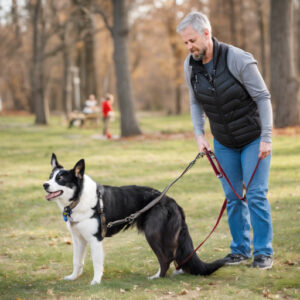 Increasing the Duration and Distance of Walks
Increasing the Duration and Distance of Walks
With consistent practice, the dog becomes more comfortable with the leash and develops trust in their handler.
As dogs spend more time walking on a leash and covering greater distances, they develop increased confidence and endurance, essential qualities for any pet.
Introducing Distractions
Gradually introduce distractions during your leash training sessions, such as:
- Other individuals
- Observing dogs from a safe distance
- Exploring unfamiliar things and encountering new sounds
For those with dogs who struggle with walking, visual leash training can be a valuable tool for teaching your dog to focus on you and the walking experience, even in the presence of distractions.
And who knows – your dog might surprise you by mastering the skill of dashing after all these years!
Always remember to acknowledge and appreciate your dog’s small achievements in their journey to becoming a better walker. It’s essential to avoid pushing them too hard or for too long during training sessions, which are already brief and enjoyable.
Troubleshooting Common Issues
It is possible to consistently resolve common problems during leash training for dogs that refuse to walk.
Here are a few possible concerns and their corresponding solutions:
Dog Pulls on the Leash
For dogs that tend to pull on the leash, a head halter or a front-attachment harness may be worth considering.
With the right tools and training, you can effortlessly regain your dog’s focus and prevent dog-pulling walks. This will create a calm and pleasant experience for you and your canine companion.
Dog Sits or Lies Down and Refuses to Move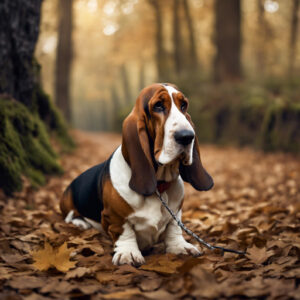
When your dog sits or lays down and refuses to move, using positive reinforcement with delicious treats is usually the most effective approach.
If that doesn’t work, you can try guiding them with the leash to encourage them to move in the opposite direction.
It’s important to avoid pulling or dragging your dog, as this can often make it more stubborn and resistant to moving.
Dog Is Easily Distracted
If your dog tends to become easily distracted, it receives high-value treats to maintain focus. During dog training sessions, using “shapes” or small food treats is customary to reinforce positive behavior and encourage focused walk-ins.
Using” these types of treats during training sessions is a practical choice, as the sight of food can quickly grab the attention of even the most easily distracted dogs.
Pet owners can effectively teach their dogs to stay focused and avoid constant distractions by utilizing positive reinforcement training techniques and carefully balancing rewards.
Dog Shows Fear or Anxiety
If your dog shows signs of fear or anxiety during leash training, use desensitization techniques and positive reinforcement to help them feel more comfortable.
Ensure that your dog is gradually introduced to the things that make them nervous, such as the leash, in a way that doesn’t cause excessive anxiety or distress. This means exposing them to low intensities where they don’t show any persistent signs of nervousness or upset.
Give them plenty of praise when they don’t remain calm during a mild stimulus. This will help them associate their calm and confident behavior with the situation that usually makes them nervous.
Tips for Successful Leash Training
To ensure success in leash training your dog:
- Practice patience and maintain consistency in your training endeavors.
- Use effective methods, such as rewards and enthusiastic encouragement, to foster positive behavior.
- Ensure your training sessions are brief and enjoyable to keep your dog interested and engaged.
- As your dog progresses, raising the bar during training sessions is essential.
- If you’re finding it difficult to make progress, it might be worth seeking guidance from experienced trainers.
Benefits of Leash Training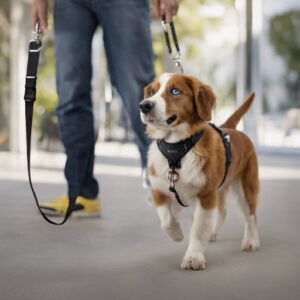
Successful leash training offers numerous benefits for both you and your dog, including:
- Enhanced safety: A dog trained to walk on a leash is less prone to running into traffic or causing other hazards.
- Enhanced control and effective communication: Leash training enables you to establish a firmer grip on your dog and plays a vital role in fostering clear communication between you and your furry companion.
- Building a strong bond and trust: Training sessions offer valuable opportunities to strengthen your connection with your beloved pet.
- Walking with a well-behaved dog on a loose leash can significantly enhance your walking experience.
Many dog owners experience the challenge of their dogs pulling on the leash and express frustration when their dogs constantly pull on the leash.
It can be particularly frustrating when people lack understanding of why their dogs engage in such behaviour and how to address it effectively.
When a dog pulls on the heel while walking, it typically indicates one of two things. Either the dog is not given enough space and time to walk at their own pace, or underlying behavioral issues may trigger the desire to run. These triggers include sights, sounds, smells (particularly those associated with other dogs), or emotions like fear or anxiety.
Final Thoughts
When faced with a dog that is resistant to walking on a leash, it may initially appear to be challenging.
With the proper approach to walking and the right techniques, you and your pet can transform from being forewarned to being forearmed, experiencing the incredible benefits that come with it.
It’s essential to maintain a calm and composed demeanor.
Consistency is crucial in this situation. During the initial few sessions of the walking school, it’s important not to have unrealistic expectations for your dog or yourself.
Gain insight into the reasons behind your dog’s reluctance to be walked on a leash – whether it’s fear of other dogs, unfamiliar surroundings, or simply exhaustion from excessive walksdog’se You have identified the issues and their uniting causes (which can sometimes be challenging to address), focus on making walks enjoyable for your dog, turning those moments into positive experiences for their overall well-being.
- Gain insight into your dog’s motivations for not wanting to walk on a leash.
- Prepare for training by selecting the appropriate collar and leash and ensuring a cheerful dog environment.
- Follow a systematic training plan that begins with indoor sessions and gradually transitions to outdoor walks.
- Address common problems by utilizing positive reinforcement and gentle guidance.
- Maintain patience and consistency in your training endeavors
If you’re struggling to make any headway with a stubborn dog, it may be time to consider enlisting the assistance of a skilled dog trainer.
They provide personalized guidance to help you overcome obstacles and motivate you to get back on track.
It’s important to remember that training your dog to walk calmly on a leash is crucial for his safety and overall happiness and for strengthening your bond with him.
So feel free to seek assistance—whether it’s to make progress or overcome obstacles—because you might feel a bit disheartened.
Enjoy your walk!
FAQs
How long does it take to train a dog that won’t walk?
The duration needed to train a dog to walk on a leash can vary depending on the dog’s age, temperament, and past experiences. Swon’togs may make noticeable improvements after just a few training sessions, while others may need several dogs or months of consistent training to see results.
What if my dog continues to refuse to walk on a leash?
If your dog continues to resist walking on a leash even after consistent training, seeking guidance from experienced dog trainers or a veterinary behaviourist can be beneficial. They have the expertise to evaluate your dog’s requirements and offer personalized advice to tackle any underlying concerns.
Can older dogs be leash-trained?
In reality, leash training older dog dogs require more time and patience than training a young puppy. It is crucial to be patient and adapt your training methods to suit your adult dog’s physical and cognitive capabilities.
What are the best treats for leash training?
Optimal treats for leash training should be small, soft, and irresistibly enticing to your furry companion. Some options for treats include small pieces of cooked chicken, cheese, or commercially available training treats. Select treats your dog loves and set them aside exclusively for training sessions.
How often should I practice leash training with my dog?
Strive to engage in leash training with your dog in brief sessions, preferably multiple times throughout the day. Ensure that your training sessions are conducted positively and engagingly, and always conclude each session on a positive note to keep your dog motivated and enthusiastic about learning.
The Post: How to Leash Train a Dog That Won’t Walk appeared first on Pet Grooming Tables.
The post Training a Dog That Refuses to Walk on a Leash appeared first on Ai Ninja Toolbox.
The Article Training a Dog That Refuses to Walk on a Leash Was Found On https://limitsofstrategy.com


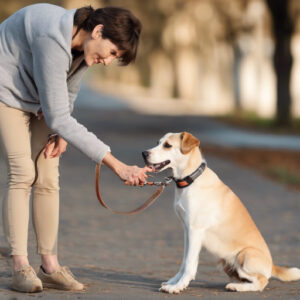


This topic resonates with me because I’ve been on the frustrating end of leash training with my own pup. I remember when my dog, Max, would just dig in his heels and refuse to budge whenever I put that leash on him. At first, I thought it might just be a phase, but it became clear that it was a combination of fear and stubbornness.
I can relate to your experience with Max; leash training can definitely test our patience. It’s interesting how our dogs’ personalities really shine through during these training moments. I had a similar experience with my dog, Bella, who would act like she was auditioning for a role in a stubbornness competition whenever the leash was introduced. I eventually realized it wasn’t just about her resisting; it was more about her feeling secure and confident in her surroundings.
It’s so true—leash training can really bring out the quirks in our dogs, can’t it? I can completely relate to Bella’s stubbornness. I think for Max, it was a mix of excitement and that feeling of security you mentioned. I started to notice that the moments he would pull or resist seemed to correlate with how comfortable he felt in certain environments. It’s like he was trying to exert a sense of control when things felt overwhelming, which makes sense considering how much our surroundings can impact their behavior.
I totally get that struggle with leash training—it’s definitely a rite of passage for many dog owners. Your experience with Max sounds really relatable; it’s interesting how a combination of fear and stubbornness can play into a dog’s behavior. I’ve seen similar things with dogs I’ve worked with. Sometimes, it feels like they have their own ideas about where they want to go, and that can lead to some pretty stubborn standoffs!
Leash training really can be quite the journey. It’s interesting how each dog seems to have their own unique personality that influences their behavior on the leash. With Max, there are days when I feel like we’re in a negotiation; he’s so set on investigating every intriguing scent or chasing after a squirrel. It does make me think about how similar dog training is to parenting or even teaching. There’s that balance between guidance and letting them express themselves.
It’s so true that leash training can feel like a rite of passage. Every dog definitely has their personality, and sometimes that personality comes with a fair share of challenges. Max, for instance, has his moments where he seems completely convinced that he has better plans than I do, particularly when there’s a squirrel in sight.
I completely agree with you—leash training really can feel like a rite of passage. It’s fascinating how every dog brings their own personality into the mix. Max definitely has his moments where he’s convinced he knows better, especially when he spots a squirrel or a particularly interesting smell. That combination of fear and stubbornness does feel like a reflective surface of broader canine traits.
It sounds like you’ve had quite the journey with Max. Leash training can really test our patience, especially when our pups seem to have their own agenda. It’s interesting how fear and stubbornness play off each other in these moments.